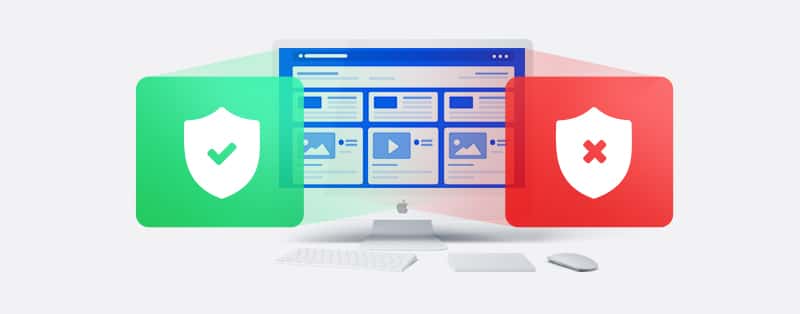How to Know if a Website Is Safe (5 Simple Steps for 2025)

As much as the internet provides solutions to many problems, there is also a place called the ‘Dark Web.’ Home to hackers and cybercriminals. Several malicious entities are waiting for openings and opportunities to steal your data and use it against you. It is no wonder internet security is the ringing anthem today.
Safety outside the internet is as important as safety on the internet; they are very similar worlds. It is vital to defend yourself from these predators looking to access your data. Website owners are responsible for ensuring that their sites are safe to visit, but you cannot always trust that this is the case.
Hackers and scammers now have several ways to trap or convince you to divulge information that can give them entry to your systems and potentially your data. One of the diverse ways they use is by taking advantage of the vulnerabilities that come with unsecured websites.
They can also fabricate a website that looks like an original one you use consistently. Many people continue to fall victim to these internet hoodlums. It is in your interest that you should be able to identify if a website is secure or not.
How to Know if a Website Is Safe
There should be a way to check if a website is safe. This is mainly because there are several fraudulent or unsafe ones on the internet. Regret will be your first name if you discover that a website is vulnerable after you have put in information that is dangerous in the hands of the wrong people. We will discuss different ways you can identify the safety of a website.
1. Pay Attention to the Address Bar
It should come as a surprise to you that most people ignore the address bar of their browsers after sending in a request. The address bar has essential information that will tell you all you need to know about the websites you visit. When you visit a website, the first thing you should do is to look at the address bar and identify important information like the domain name. Most phishing attacks make you believe that you are on the right site. If you look closely at the URL (Uniform Resource Locator) or domain name, you might notice it is different from the original. Paying close attention to your address bar is the first step to ensure that a website is safe to use.
2. Check Security Indicators/Certificates
In the address bar, specific indicators show you if your connection to a website is secure or not. You should see either HTTPS or HTTP when you take a look at the URL of your browser. HyperText Transfer Protocol is the primary communication protocol between web servers and clients. Any internet conversation using HTTP is sent in plaintext, and malicious entities can hijack it; this is why you should not send sensitive information with HTTP. HTTPS is the secure version of HTTP: it is a combination of HTTP and TLS (Transport Layer Security). TLS protects your internet connection by encrypting communications over the internet; a website must go through a validation procedure to get a TLS certificate.
Another indicator that is easier to see is the padlock icon. A closed padlock badge on the address bar indicates that a website uses HTTPS and your connection is safe. You can see more information about the TLS certificate and the company that validates it if you click on the padlock badge. There is also the possibility of a site having HTTPS on its address bar, and the padlock icon is missing; this can mean a problem with your connection.
3. Check the Website’s Privacy Policy
A privacy policy is an excellent place to start if you want to know how a website protects, collects, and uses your data. It should convey these things without any form of confusion. In many countries, a website must have a privacy policy in line with the data privacy laws of its government or region. Companies are now making sure that their privacy policy reflects the truth of what they do with your data because they are liable by law to do so.
For example, the European Union regulates companies that operate in its region using the GDPR (General Data Protection Regulation). Any company not complying with it will be at the risk of a fine or losing operation in the European Union. So if you can’t find a proper privacy policy or you don’t understand how the website uses your data after reading the policy, chances are your data is not safe.
4. Verify Trust Seals
A trust seal on a website is a way for owners of the site to show they are trustworthy, not because they say so but because a reliable third-party company or association says so. In most cases, it is to verify that their connection is secure by the use of HTTPS. You are likely to have seen a trust seal; it is usually on the homepage, login page, or the checkout page of an e-commerce site.
What many people don’t know is that you can verify a trust seal by clicking on it. SSL/TLS certificates sometimes come with a trust seal that displays information that confirms the security of the website you’re on. You can also get information about other security mechanisms a website employs by clicking on a trust seal. A trust seal you click will take you to a page where you can verify its authenticity to determine if it’s genuine.
5. Use the Google Safe Browsing Transparency Report
The Google Transparency Report is a service put together by Google’s security team to find unsafe websites on the internet and alert users of possible danger. It’s a site where you can put in the URL of any website in a search field, and it gives you a security report of the website. It is a potent way to figure out if a website is safe or not.
How to Protect Yourself From Unsafe Websites
Now that you know several ways to determine if a website is safe, it is imperative you know how to protect yourself from unsafe websites.
1. Take Advantage of Your Browser’s Safety and Security Tools
Browsers now come with safety tools to ensure users are safe while browsing. These built-in tools will identify malicious websites and alert you when you come across them. They can also block ads, block tracking cookies, control site permissions, and disable hazardous content. There are also add-ons you can add to your browser that will give you specific protection, like ensuring sites use HTTPS.
2. Use an Antivirus With Online Protection Features
Using an antivirus to protect your computer is critical. Most of these antivirus applications come with built-in online protection features and tools. They can alert you if a website you’re on is not secure. Other features like malware protection, enhanced tracking protection, and TLS certificate verification are also useful in ensuring your safety. You can also have a blacklist of unsafe websites that you don’t want to visit. Although it may cost you some money, a proper antivirus will give you the protection you need to be safe.
Can a VPN Help?
A Virtual Private Network creates an encrypted tunnel to keep your internet connection secure. When using a VPN, anything you send over your internet connection is encrypted so that no one can monitor your movement or steal your data. A VPN can help if you’re browsing on a site that uses HTTP.
When you connect to such sites, the VPN keeps all communications between the web server, client, and ISP secure. It is important to note that any sensitive data put on a malicious site is usually sent to the site owner regardless of whether you use a VPN or not. What does this mean?
When you send a legitimate HTTP request to a server using a VPN, the VPN protects your request from any snooping by malicious entities. If the owner of the server is a hacker that tricks you into sending that request, there is nothing a VPN can do to help you. So while a VPN can help, it has its limits when it comes to protecting you from unwanted harm.
Conclusion
Despite providing us with a vast amount of information and communication tools, the internet and world wide web has also given us the best of the dark side: hackers, scammers, and all sorts of cybercriminals.
The presence of these bad guys on the internet should make you more conscious of protecting our data online. Ensuring you can identify a malicious webpage and protecting yourself from falling into the traps of cyber scammers should become natural to you.
It is important to note that the cost of losing sensitive data is usually more than that of keeping it safe. You must employ various ways and methods to safeguard the time you spend on the internet.
Join the TechRobot Newsletter
Actionable tips on online security, the best VPNs, unblocking guides, and special offers — straight to your inbox.
